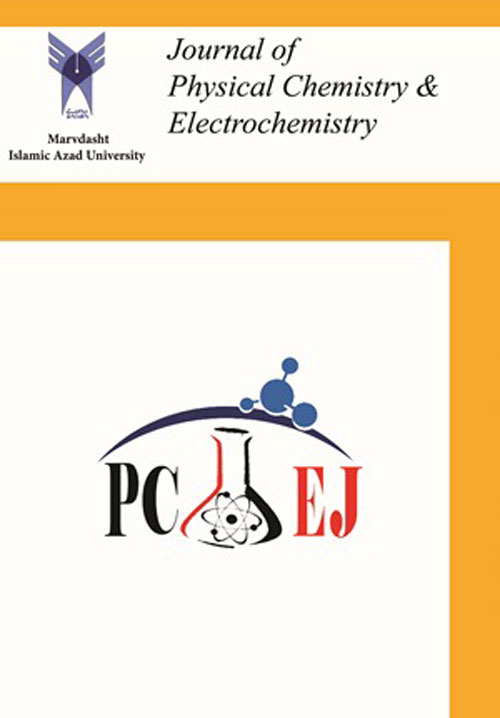فهرست مطالب
Journal of Physical Chemistry & Electrochemistry
Volume:4 Issue: 1, 2016
- تاریخ انتشار: 1395/06/18
- تعداد عناوین: 7
-
Pages 56-65An analytical equation of state (EOS) developed by Ihm-Song-Mason (ISM) has been applied to calculate some thermophysical properties of molten polymers including Poly (1-octene) (PO), Poly (vinyl methyl ether) (PVME), Poly (vinyl chloride) (PVC), and Poly (styrene) (PS). Three temperature-dependent parameters of the ISM EOS have been determined based on the alternative scaling constants, dispersive energy parameters between segments/monomers (ε) and segment diameter (σ). The ability of the proposed EOS has been checked by comparing the results with 547 literature data points for the specific volumes over temperature from 311-557 K and pressure ranging from 0.1 up to 200 MPa. The average absolute deviation (AAD) of the calculated specific volumes from literature data was found to be 0.47%. The isothermal compressibility coefficients, κT have also been predicted using ISM EOS. From 188 data points examined, the AAD of estimated κT was equal to 7.75%. Our calculations on the volumetric and thermodynamic properties of studied polymers reproduce the literature data with reasonably good accuracy.Keywords: Equation of state, Molten Polymers, Thermodynamic properties
-
Solitonic states in organic conducting polymersPages 65-71
-
Pages 67-74The protonation constant values of salicylic and 5-nitrosalicylic acid werestudied by a combination of spectrophotometric and potentiometric methods at 25 °C in wide range of ionic strength. The ionic strength of solutions was kept constant by sodium perchlorate as background electrolyte at 0.10 to 3.0 mol dm-3. Potentiometer was calibrated according to Gran method at each of ionic strength. The pKa values were calculated using STAR program by multivariate curve fitting of absorbance data. The dependence of deprotonation constants on ionic strength were explained by means of Specific ion Interaction Theory (SIT). Activity coefficients of species were calculated by a modified SIT approach. The specific ion interaction parameters were extracted associated with the thermodynamic protonation constant.Keywords: pKa, Salicylic acid, Ionic Strength, Specific ion Interaction Theory
-
Pages 73-85An agricultural waste and eco-friendly biosorbent i.e. rice husk has been used as a cheap adsorbent for the removal of methylene blue dye from aqueous solutions. The physical properties of the developed adsorbent were characterized using FTIR. The study was realized using batch experiments. The effects of contact time, pH, initial dye concentration, biosorbent dose and temperature were investigated. The adsorption data were evaluated by Freundlich and Langmuir isotherm models. The adsorption isotherm is best fitted by the Freundlich model, while the adsorption kinetics is well described by the pseudo-secondorder model. Different thermodynamic parameters i.e., changes in standard free energy, enthalpy and entropy have also been evaluated and it has been found that the dye adsorption onto rice was a spontaneous, endothermic and physical reaction.Keywords: Rice husk, Biosorption, Kinetic study, Isotherm, methylene blue, basic dye
-
Pages 86-92A new and simple method followed by atomic absorption spectrometry has been developed for indirect determination of ascorbic acid (AA). The proposed method was based on the oxidation of AA to dehydroascorbic acid with Cu2熫抢(200mgL-1)in an ammonium thiocyanatesolution at pH2.4. AA reduces Cu2 Cu纉斣ޝ by the precipitation of Cu with SCN-. Then, the excess of Cu2 the solution was measured by the atomic absorption spectrometry.The results showed that AA can be sensitively measured in the linear range of 2.0 to 40.0 mgL-1 with the detection limit of 1.5mgL-1.The relative standard deviation (%RSD) was 0.319 in 7 determination of 2.0 mgL-1 AA. Finally, the method was successfully used for the determination of AA in tablets containing various amounts of AA.Keywords: Ascorbic acid, indirect determination, atomic absorption spectroscopy
-
Pages 93-101A three-parameter cubic equation of state has been proposed for predicting PVT of pure refrigerants such as R236ea, R236fa, R245fa, R245ca, R218, R227ea, and R717, from freezing point up to critical point temperature and pressures up 650 atm. We explore the theory of the equation of state from the view point of IhmSongMason (ISM) equation of state, which has been derived on the basis of statistical mechanical perturbation theory, and is characterized by three temperature dependent parameters, a, b, B2 , and a free parameter λ. The second virial coefficients are calculated from a correlation based on the heat of vaporization, ΔHvap, and the liquid density at the normal boiling point, ρnb. α(T ) and b(T ) can also be calculated from second virial coefficients by a scaling rule. The theory has considerable predictive power, since it permits the construction of the PVT surface from the heat of vaporization and the liquid density at the normal boiling point. The results indicate that the liquid densities can be predicted with very good agreement over a wide range of temperatures, 100400 K.Keywords: Equation of state, correlation, Heat of Vaporization, Saturation Liquid Density of Refrigerants
-
Pages 102-112In this work, the effects of As-doped on the adsorption of oxygen gas on the outer and inner surface of boron nitride nanotube (BNNTs) is investigated. The structural parameters, quantum properties involving: bond length, bond angle, HOMO-LUMO orbital, gapenergy, electron affinity, electronegativity, chemical potential, global hardness, global softness and NMR parameters of BNNTs are calculated at different configurations of O2adsorption on the outer and inner surface of BNNTs by performing density functional theory (DFT) using Gaussian 03 package of program. Our results reveal that the adsorption energy of all models is exothermic and the Eads value in (A and B) undoped models of BNNTs is larger than those of the other models. The results show that As-doped impurities and O2 adsorption decrease the adsorptionenergy of O2gas on the surface of BNNTs andthe gap energy between HOMO-LUMO orbitaland increase the conductivity of nanotube.Keywords: BNNTs, Adsorption O2, As-doped, DFT, NMR


